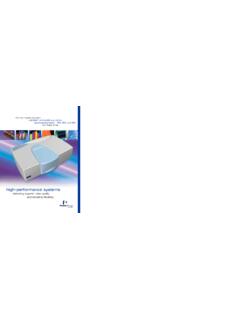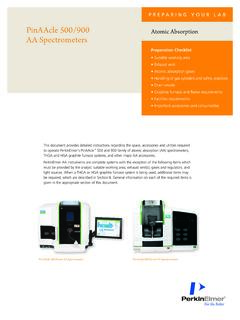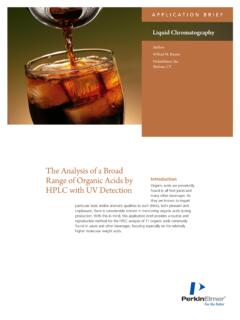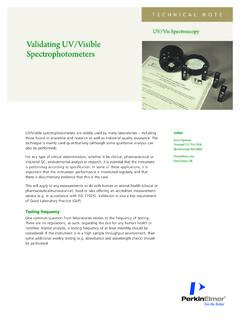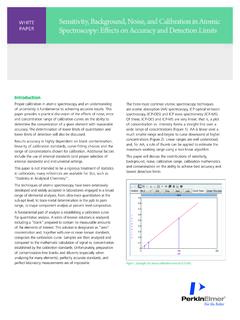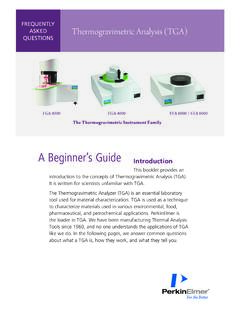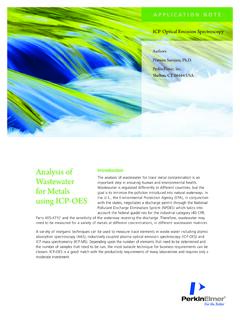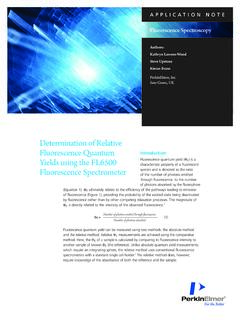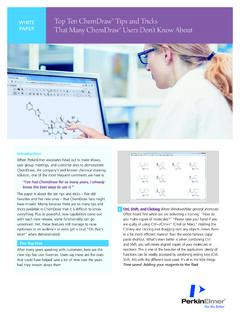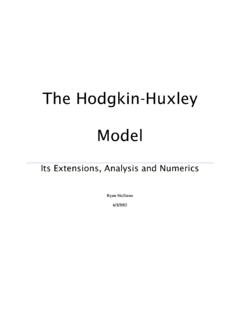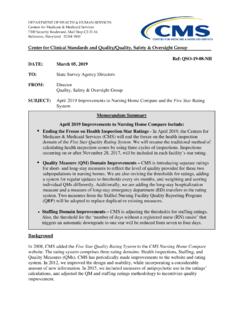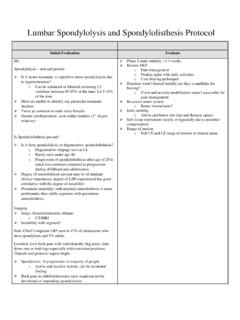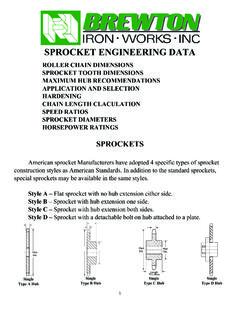Transcription of A Beginner's Guide - PerkinElmer
1 FREQUENTLY ASKED QUESTIONSD ifferential Scanning Calorimetry (DSC) PerkinElmer 's DSC FamilyA Beginner's Guide This booklet provides an introduction to the concepts of Differential Scanning Calorimetry (DSC). It is written for the materials scientist unfamiliar with differential scanning calorimeter (DSC) is a fundamental tool in thermal analysis. It can be used in many industries from pharmaceuticals and polymers, to nanomaterials and food products. The information these instruments generate is used to understand amorphous and crystalline behavior, polymorph and eutectic transitions, curing and degree of cure, and many other material properties used to design, manufacture, and test products. While DSCs are manufactured in several variations, PerkinElmer is the only company to make both single- and double-furnace styles.
2 We have manufactured thermal analysis instrumentation since 1960, and understand applications better than anyone in the industry. In the following pages, we answer common questions about how a DSC works, and what it tells you about the thermal properties of materials you work with in your 4000 DSC 8000 DSC 8500 with AutosamplerDSC 6000 with Autosampler2 Table of Contents20 Common Questions about DSC What is DSC? ..3 What is the difference between a heat flow and a heat flux DSC? ..3 How does the difference affect me? ..3 Why do curves point in different directions? ..4 What is heat capacity? ..4 Why is measuring the glass transition important? ..4 Why should I measure melting by DSC? ..5 What else can I learn from DSC data? ..5 How do I obtain good data? ..5 How can I improve my data?
3 6 Why doesn t my data agree with other thermal techniques? ..6 What is the difference between controlled and ballistic cooling? ..6 Why should I care about isothermal performance? ..7 How do I study oxidative stability? ..7 When do I need to use HP-DSC? ..7 When should I consider using UV-DSC? ..7 How are kinetic studies done with a DSC? ..7 What is Modulated Temperature DSC? ..7 What is Fast Scan DSC or HyperDSC ? ..8 What hyphenated techniques work with DSC? ..8 Glossary ..8-9 Additional Resources ..9320 Common Questions about DSCQ What is DSC?A Differential Scanning Calorimetry, or DSC, is a thermal analysis technique that looks at how a material s heat capacity (Cp) is changed by temperature. A sample of known mass is heated or cooled and the changes in its heat capacity are tracked as changes in the heat flow.
4 This allows the detection of transitions such as melts, glass transitions, phase changes, and curing. Because of this flexibility, since most materials exhibit some sort of transitions, DSC is used in many industries, including pharmaceuticals, polymers, food, paper, printing, manufacturing, agriculture, semiconductors, and biggest advantage of DSC is the ease and speed with which it can be used to see transitions in materials. If you work with polymeric materials of any type, the glass transition is important to understanding your material. In liquid crystals, metals, pharmaceuticals, and pure organics, you can see phase changes or polymorphs and study the degree of purity in materials. If you are processing or distilling materials, knowledge of a material s heat capacity and heat content change (called enthalpy) can be used to estimate how efficiently your process is operating.
5 For these reasons, DSC is the most common thermal analysis technique and is found in many analytical, process control, quality assurance, and R&D What is the difference between a heat flow and a heat flux DSC?A The term differential scanning calorimetry refers to both the technique of measuring calorimetric data while scanning, as well as a specific instrument design. The technique can be carried out with other types of instruments. Historically, temperature transitions in materials were first seriously studied by the ceramic industry in the 1800s using differential thermal analysis (DTA). This early work was done by placing a thermometer into a material and heating it in an oven, similar to the way a meat thermometer is used. There were some seri-ous problems with this as placement of the thermometer was often not reproducible.
6 This was solved by S. L. Boersma s development of the fixed thermocouple differential thermal analyzer. Analyzers of this design are still common today and are called Boersma Differential Thermal Analysis (DTA).In the 1960s, Mike O Neill of PerkinElmer developed the first double-furnace, or power controlled DSC in order to measure heat flow, the movement of heat in and out of a sample, directly. This instrument uses a feedback loop to maintain the sample at a set temperature while measuring the power needed to do this against a reference furnace. This allows for very precise control of temperature, very accurate enthalpy and heat capacity measurements, and true isothermal performance. Because of its direct measurement of heat flow, it is often called heat flow Boersma DTA can also be used to calculate heat flow with the right calibrations and is also used for the DSC technique.
7 This is accomplished by measuring temperature differences and changes between a sample and a refer-ence, or the heat flux. These instruments are sometimes called heat flux DSCs. Like all DTA designs, the Boersma really measures the temperature difference (T) and calculates heat flow from calibration data. Because of their single furnace design, heat flux DSCs are less sensitive to small transitions, heat and cool at slower rates than heat flow DSC, and give less accurate values for Cp and How does the difference affect me?A For the vast majority of simple applications, the data from both types of instruments are comparable and both instruments can provide good data. However, both designs have strengths and weaknesses, and if you are doing more than just looking at simple glass transitions and melts, you may need one or the other.
8 Some of the differences are given in Table 1. Double-furnace design allows the direct measurement of heat 1. Heat Flow Versus Heat Flux DSC. Heat Flow Heat FluxFast Heating (250 C/min plus) Yes NoModulated Techniques Yes YesAccuracy of Cp Values High ModerateDelta H Accuracy High ModerateEase of cleaning Very ModerateOIT Testing Moderate Easy Isotherm Performance Excellent Affected by sample4Q Why do curves point in different directions? A As shown in Figure 2, this is a convention based on how the instruments work. In a heat flow DSC, the endo-thermic peaks those events which require energy point up because the instrument must supply more power to the sample to keep the sample and reference furnaces at the same temperature. In a heat flux DSC, these same events cause the sample to absorb heat and be cooler than the furnace, so they point down.
9 The reverse logic applies to exothermic events where energy is released. The International Conference on Thermal Analysis and Calorimetry (ICTAC) sets the convention that curves should follow this pattern many years ago. Most modern software systems let you flip the curves as you What is heat capacity?A Heat capacity (Cp) is the amount of energy a unit of matter can hold. Think of a can of green pea soup: it is a gelatinous mass at room temperature, but as it heats up in a saucepan it becomes more fluid. Its heat capacity also increases and the fluid soup at 100 C can hold more energy than the solid at room temperature. All materials show this increase in heat capacity with temperature. It is reported as either J/g, J/Mol, or as calories/g in the older heat capacity increases with temperature, the run of a real sample should show a slight upward slope toward a higher temperature.
10 There is also a step change in the baseline across the melt as the heat capacity of a molten material is higher than that of a solid. Lack of these features suggests some form of data manipulation. Of course, a strong peak will dwarf these features. Heat capacity may seem academic, but it turns out to have lots of practical implications, and engineers often need it. For example, when running an extruder for polymeric or food products, knowing the heat capacity of the material can help you figure out how efficient your process is and whether you are using too much energy. You can use it to calculate the energy needed to run a distillation or recycle column, or to estimate how much energy is needed to keep something at a certain temperature. Figure 2. Above is a comparison of curves for a nylon from a double furnace DSC (solid line) and a single furnace heat flux DSC (Boersma DTA).
